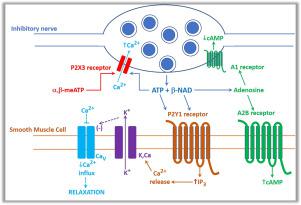Autonomic Neuroscience ( IF 3.2 ) Pub Date : 2021-06-05 , DOI: 10.1016/j.autneu.2021.102830 Brian F King 1

|
The ATP analogue α,β-meATP is a potent relaxant of gastrointestinal smooth muscle, but its molecular target is uncertain inside the gut. α,β-meATP relaxed the carbachol-precontracted guinea-pig taenia coli in a concentration-dependent manner (EC50, 2.0 ± 0.1 μM). A luciferase-based assay confirmed that α,β-meATP solutions were minimally contaminated with ATP. α,β-meATP-evoked relaxations were inhibited by the competitive P2Y1 antagonist MRS2179 (pA2 = 5.36), but also by the competitive P2X3 antagonist, A-317491 (pA2 = 5.51). When MRS2179 and A-317491 were applied together, residual α,β-meATP responses converted from brief to prolonged relaxations. Sodium nitroprusside (a nitric oxide donor) also caused prolonged relaxations. Immunohistochemistry revealed that P2X3 receptors were present in myenteric ganglion cells and their varicose nerve terminals. The amplitude of α,β-meATP responses was not inhibited by TTX (NaV channel blocker) and ωCgTx (N-type CaV channel blocker). However, responses to α,β-meATP were inhibited by TEA (non-selective K+-channel blocker), indicating that relaxations involved opening K+-channels. The findings of this study are consistent with the conclusion that α,β-meATP stimulates Ca2+-permeable P2X3 receptors on varicose nerve terminals to release inhibitory nucleotides: 1) ATP and β-NAD release results in P2Y1-mediated brief relaxations; 2) another released transmitter (possibly NO) results in prolonged relaxations. Prejunctional P2X3 receptors represent a purinergic feed-forward mechanism to augment the action of inhibitory nerves on gut motility. This positive feed-forward mechanism may counter-balance the known negative feedback mechanism caused by adenosine and prejunctional A1 receptors on inhibitory motor nerves.
中文翻译:

P2X3受体参与胃肠平滑肌的嘌呤能抑制
ATP 类似物 α,β-meATP 是一种强效的胃肠平滑肌松弛剂,但其分子靶点在肠道内尚不确定。α,β-meATP加入放宽以依赖于浓度的方式的卡巴胆碱预先收缩的豚鼠结肠带大肠杆菌(EC 50,2.0±0.1微米)。基于荧光素酶的测定证实 α,β-meATP 溶液被 ATP 污染最小。α,β-meATP 诱发的松弛被竞争性 P2Y1 拮抗剂 MRS2179 (pA 2 = 5.36)抑制,但也被竞争性 P2X3 拮抗剂 A-317491 (pA 2 = 5.51)。当 MRS2179 和 A-317491 一起使用时,残留的 α,β-meATP 反应从短暂的松弛转变为长期的松弛。硝普钠(一氧化氮供体)也会导致长时间的放松。免疫组织化学显示 P2X3 受体存在于肌间神经节细胞及其曲张的神经末梢。α,β-meATP 反应的幅度不受 TTX(NaV 通道阻滞剂)和 ωCgTx(N 型 CaV 通道阻滞剂)的抑制。然而,对 α,β-meATP 的反应被 TEA(非选择性 K +通道阻滞剂)抑制,表明松弛涉及打开 K +通道。本研究结果与α,β-meATP刺激Ca 2+的结论一致- 静脉曲张神经末梢上的可渗透 P2X3 受体以释放抑制性核苷酸:1) ATP 和 β-NAD 释放导致 P2Y1 介导的短暂放松;2)另一个释放的发射器(可能是NO)导致长时间的放松。结前 P2X3 受体代表一种嘌呤能前馈机制,可增强抑制性神经对肠道运动的作用。这种正前馈机制可能会抵消由腺苷和抑制性运动神经上的结前 A1 受体引起的已知负反馈机制。











































 京公网安备 11010802027423号
京公网安备 11010802027423号